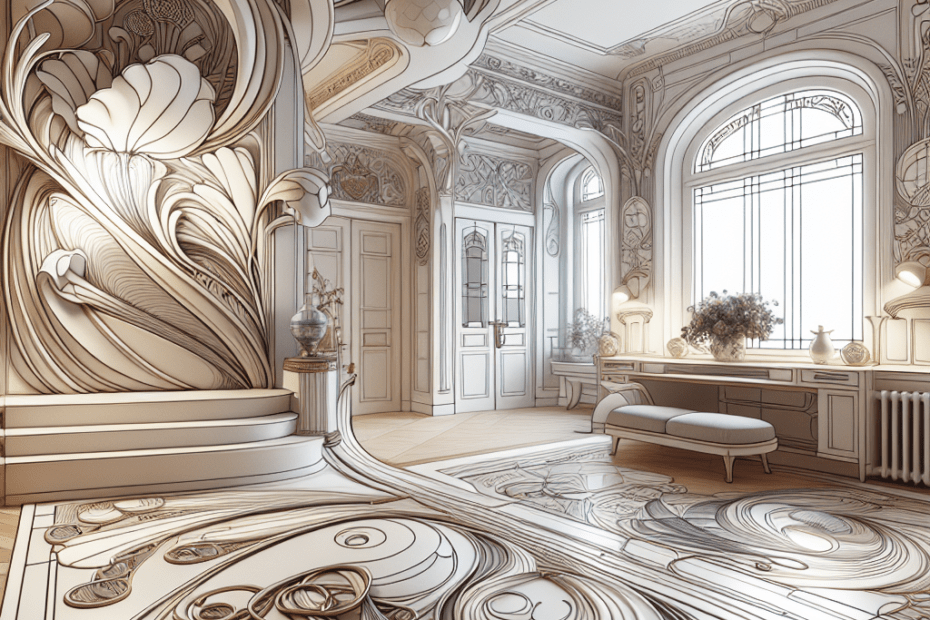“`html
The Essentials of Art Nouveau Design in Interiors
At the turn of the 20th century, Art Nouveau Design began to transform interiors worldwide. This art movement, characterized by its fluid lines, natural forms, and intricate details, brought a new elegance to homes and public spaces. As they explore Art Nouveau Design, individuals are drawn to its harmonious blend of art, architecture, and nature.
Understanding Art Nouveau Design
Art Nouveau, which means “New Art” in French, emerged in Europe between 1890 and 1910. It was a reaction against the academic arts of the 19th century. Art Nouveau Design focused on creating a total work of art, with the goal of infusing artistic quality into everyday objects. The movement emphasized craftsmanship and encouraged designers to look to nature for inspiration, resulting in flowing, organic lines and asymmetrical shapes.
Key Characteristics of Art Nouveau Interiors
Art Nouveau’s distinct style can be identified through several key characteristics:
- Curvilinear Forms: One of the most recognizable features, the use of sleek, curvy lines mimicked vines and flowers.
- Natural Motifs: Designs often included depictions of plants, insects, and other nature-inspired elements.
- Ornate Details: Intricate patterns and elaborate designs were common, bringing a sense of luxury and detail to every element.
- Combination of Materials: The use of glass, wrought iron, wood, and ceramics showcased the versatility of Art Nouveau Design.
- Focus on Light: Natural light played a crucial role, with designs allowing for large windows and stained glass elements that altered the mood and atmosphere of a space.
The Influence of Art Nouveau in Modern Interiors
Today, Art Nouveau Design continues to inspire architects and interior designers. Its principles can be seen in the work of contemporary designers who appreciate its seamless marriage of form and function. While complete Art Nouveau interiors are rare, elements such as floral motifs, curved furniture, and stained glass are still popular in modern design.
According to a 2022 survey by Houzz, 35% of homeowners looking to renovate their spaces chose to include elements of historical styles like Art Nouveau, with many citing the style’s elegance and timeless appeal (Houzz).
Art Nouveau Design Elements to Incorporate
For those looking to bring Art Nouveau Design into their homes, consider the following elements:
| Design Element | Description |
|---|---|
| Furniture | Curved wooden pieces with intricate carvings, often mimicking plant forms. |
| Lighting | Stained glass lamps and elaborate sconces that play with light and shadow. |
| Textiles | Rich fabrics featuring organic patterns, often in deep, saturated colors. |
| Art | Wall art or tapestries depicting natural scenes or figures, with flowing lines and ornate detail. |
| Wall Treatments | Wallpaper with botanical prints or hand-painted murals reflecting nature’s beauty. |
Challenges in Adopting Art Nouveau Design
While Art Nouveau Design is captivating, it can be challenging to implement wholly in contemporary spaces. Some may find it difficult to balance the ornate details with modern minimalism. Additionally, sourcing authentic Art Nouveau pieces can be costly and time-consuming. Despite these challenges, the artful integration of a few key elements can transform an interior, adding character and charm.
Future Trends
Art Nouveau Design is seeing a resurgence in interest as people look for ways to add personality and timeless beauty to their homes. With increasing awareness of sustainable design, many are attracted to the style’s emphasis on craftsmanship and natural materials. In the coming years, designers may continue to draw on these concepts, merging them with contemporary aesthetics to create unique, livable spaces.
Key Takeaways
- Art Nouveau Design originated as a reaction against the rigid academic arts of the 19th century.
- Key characteristics include curvilinear forms, natural motifs, and ornate details.
- 35% of homeowners planning renovations incorporate elements inspired by historical styles like Art Nouveau.
- Integrating furniture, lighting, and textiles can bring elements of Art Nouveau into modern homes.
- Current trends show a blend of Art Nouveau aesthetics with contemporary design approaches.
FAQ
-
What inspired Art Nouveau Design?
Art Nouveau was inspired by natural forms and structures, especially plants and flowers, aiming to bring beauty and craftsmanship to everyday objects.
-
How can one identify Art Nouveau interiors?
Look for features like curvy lines, natural motifs, stained glass, and a mix of materials such as wood and iron with ornate designs and intricate details.
-
Is Art Nouveau Design still popular today?
Yes, elements of Art Nouveau remain popular for their elegant and timeless appeal, and they are often incorporated into modern design.
-
What materials are commonly used in Art Nouveau furniture?
Common materials include wood, wrought iron, glass, and ceramic, with a focus on craftsmanship.
-
What challenges might one face when adopting Art Nouveau Design?
Challenges include finding authentic pieces, balancing ornate details with minimalism, and managing costs.
“`
